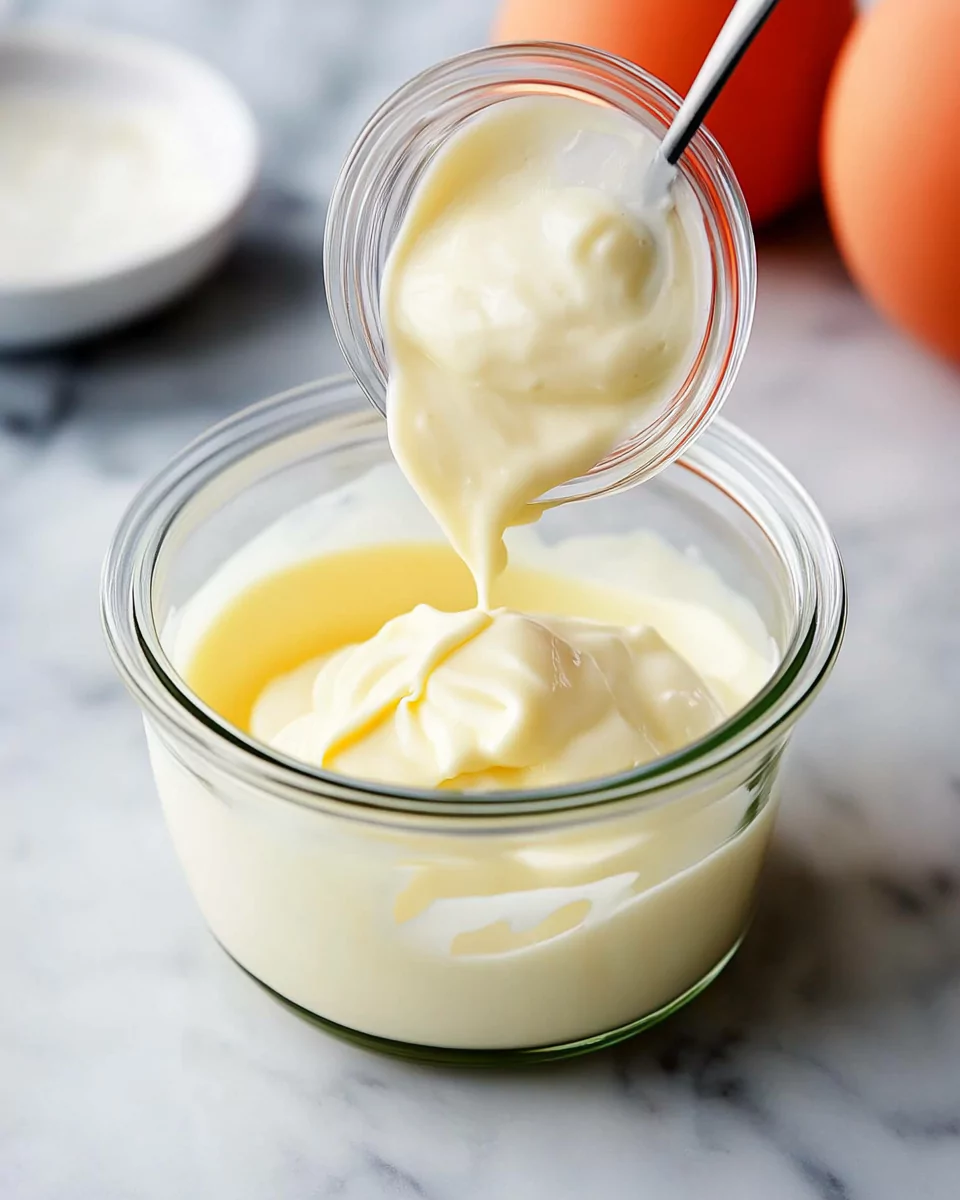A quick, creamy, and foolproof recipe to make your own delicious mayonnaise at home in less than one minute!

Why You’ll Love This Recipe
- Quick and Easy: Ready in under 1 minute with minimal effort.
- Fresh Ingredients: Made with wholesome pantry staples for superior taste.
- Versatile: Perfect for sandwiches, dips, and dressings.
- Customizable: Adjust seasonings to suit your taste.
Preparation Phase & Tools
Essential Tools and Equipment
- Immersion Blender: Key to achieving perfect emulsification.
- Tall, Narrow Jar: Helps blend ingredients evenly without splashes.
- Airtight Storage Container: Keeps your mayonnaise fresh and safe.
Importance of Each Tool
- Immersion Blender: Delivers the right consistency quickly and reliably.
- Narrow Jar: Ensures that all ingredients are emulsified properly.
- Storage Container: Keeps the mayo fresh and ready for use.
Preparation Tips
- Use room-temperature eggs for optimal emulsification.
- Avoid vigorously moving the blender too soon to prevent separation.
- Opt for mild-flavored oils to enhance, not overpower, the taste.
Ingredients
- 1 whole egg
- ½ tablespoon lemon juice
- 1 teaspoon white wine vinegar
- ¼ teaspoon Dijon mustard
- ¼ teaspoon sea salt
- 1 cup avocado oil (or light-flavored olive oil)
Step-by-Step Directions
- Combine Ingredients:
- Add the egg, lemon juice, vinegar, mustard, and salt to a tall, narrow jar.
- Slowly pour the oil over the ingredients, allowing it to settle for about one minute.
- Start Blending:
- Insert the immersion blender into the jar, ensuring it rests firmly on the bottom.
- Blend for 10–15 seconds without moving the blender until the mixture begins to emulsify and thicken.
- Finish Blending:
- Slowly move the blender up and down to incorporate the remaining oil fully.
- Store:
- Transfer the mayonnaise to an airtight container.
- Refrigerate and use within one week.
Lisa’s Tips
- Oil Choice: Use avocado oil or light olive oil for the best flavor. Avoid strong oils like extra virgin olive oil.
- Stick Blender: This tool works best for ensuring proper emulsification.
- Video Tutorial: Watch a video guide if you’re new to making mayonnaise.
Serving Suggestions
Homemade mayonnaise is a versatile condiment that elevates many dishes. Here are some delightful ways to serve it:
- Sandwiches & Wraps: Spread on bread or tortillas for a creamy layer.
- Salad Dressings: Use as a base for classic or flavored dressings like ranch or Caesar.
- Veggie Dip: Pair with fresh or roasted vegetables for a satisfying snack.
- Fries & Chips: Serve as a dip for fries, sweet potato wedges, or even chips.
- Grilled Meats: Use as a sauce for grilled chicken, steak, or burgers.
- Tuna or Chicken Salad: Mix with protein for a creamy, flavorful salad.
- Deviled Eggs: Create rich, tangy fillings for deviled eggs.
- Coleslaw: Toss with shredded cabbage and carrots for a refreshing side.
Common Mistakes To Avoid & How to Perfect the Recipe
1. Using Strong-Flavored Oil
- Mistake: Oils like extra virgin olive oil can overpower the taste.
- Solution: Stick to mild oils such as avocado or light olive oil for a balanced flavor.
2. Blending Incorrectly
- Mistake: Moving the immersion blender too soon can cause separation.
- Solution: Start blending at the bottom and only move the blender once the mixture emulsifies.
3. Not Using Room-Temperature Eggs
- Mistake: Cold eggs can prevent proper emulsification.
- Solution: Use room-temperature eggs for best results.
4. Overmixing the Mayo
- Mistake: Blending for too long can break the emulsion.
- Solution: Stop blending as soon as the ingredients are fully combined.
5. Improper Storage
- Mistake: Leaving mayonnaise uncovered or at room temperature.
- Solution: Always store in an airtight container and refrigerate immediately.
Side Dish Recommendations
Pair your homemade mayonnaise with these crowd-pleasing sides:
- Roasted Vegetables: Use the mayo as a dipping sauce or drizzle.
- Sweet Potato Fries: Enhance their natural sweetness with a spicy mayo dip.
- Fresh Green Salad: Toss with a mayo-based dressing for a creamy texture.
- Grilled Corn: Slather with mayo and sprinkle with paprika and cheese for an elote-inspired treat.
- Homemade Burgers: Spread on buns or mix into patties for added moisture.
- Tuna Salad: Mix with tuna, celery, and seasonings for a quick and easy dish.
- Coleslaw: Combine with shredded cabbage for a classic BBQ side.
- Potato Wedges: Serve alongside roasted potatoes for a satisfying pairing.
Recipe Tips
- Use Fresh Eggs: Fresh eggs ensure the best flavor and safer consumption, as this recipe involves raw eggs.
- Add Flavor Variations: Customize your mayonnaise with:
- Garlic: For a garlic aioli-style mayo.
- Paprika or Chili Powder: For a smoky or spicy kick.
- Herbs: Add fresh parsley, dill, or basil for herb-infused mayo.
- Blend with Care: Start blending at the bottom and only move upward once emulsification begins.
- Watch for Freshness: Always taste your mayonnaise after blending and adjust seasonings if needed.
Storage and Reheating Instructions
Storage
- Container: Store the mayonnaise in an airtight container to maintain freshness.
- Refrigeration: Keep it in the refrigerator at all times.
- Shelf Life: Use within 1 week for the best flavor and safety.
Reheating
- Not Applicable: Mayonnaise should not be reheated. Serve cold or at room temperature for best results.
FAQs
1. Can I use a regular blender instead of a stick blender?
Yes, but an immersion blender is more reliable for achieving perfect emulsification. A regular blender may require more effort to prevent separation.
2. Why didn’t my mayonnaise thicken?
This can happen if the egg or oil is too cold, or if the blending process is interrupted. Ensure the egg is room temperature, and blend starting from the bottom.
3. Can I freeze mayonnaise?
Freezing is not recommended, as it alters the texture and makes the mayonnaise watery upon thawing.
4. What’s the best oil for mayonnaise?
Mild oils like avocado oil or light olive oil work best. Strong-flavored oils, such as extra virgin olive oil, can overpower the taste.
5. How can I fix separated mayonnaise?
If your mayonnaise separates, add a fresh egg yolk to a clean jar, then slowly whisk in the separated mixture until it re-emulsifies.
6. Is homemade mayonnaise safe to eat?
Yes, if made with fresh eggs and stored properly in the refrigerator, it is safe to consume within one week.
7. Can I make vegan mayonnaise?
Yes! Replace the egg with aquafaba (the liquid from canned chickpeas) and follow the same steps. Use plant-based oils for a completely vegan option.
Conclusion
Making your own easy homemade mayonnaise is a rewarding experience that offers unmatched freshness and flavor. This simple recipe, which uses basic pantry staples, is a healthier and tastier alternative to store-bought options. Whether you’re spreading it on sandwiches, mixing it into salads, or serving it as a dip, this versatile condiment will elevate your meals. Try it today and enjoy the difference of homemade!
Easy Homemade Mayonnaise
Ingredients
- 1 whole egg
- ½ tablespoon lemon juice
- 1 teaspoon white wine vinegar
- ¼ teaspoon Dijon mustard
- ¼ teaspoon sea salt
- 1 cup avocado oil or light-flavored olive oil
Instructions
Combine Ingredients:
- Add the egg, lemon juice, vinegar, mustard, and salt to the jar that came with your immersion blender. Slowly pour the oil on top of the ingredients, allowing it to settle for about one minute.
Start Blending:
- Place the immersion blender into the jar, ensuring it is pressed firmly against the bottom and covers the egg yolk. Turn the blender on and keep it stationary at the bottom of the jar for 10-15 seconds as the mixture begins to emulsify and thicken.
Finish Blending:
- Once the mayonnaise starts to emulsify, slowly move the blender up and down to fully incorporate all the ingredients.
Store:
- Transfer the mayonnaise to an airtight storage container and refrigerate.
Notes
Oil Choice: Use avocado oil or a light-flavored olive oil for the best taste. Avoid strongly flavored oils, like extra virgin olive oil, which can overpower the flavor.
Stick Blender: A stick blender works best for this recipe and ensures proper emulsification.
Video Tutorial: Watch the video for step-by-step guidance.
Notes
Storage: Store the mayonnaise in an airtight container in the refrigerator for up to 1 week.
Use Fresh Eggs: Because this recipe uses raw egg, ensure you’re using the freshest eggs possible and keep the mayonnaise refrigerated.
Serving Ideas: Use this homemade mayonnaise for sandwiches, dressings, or as a dip.




Leave a Comment